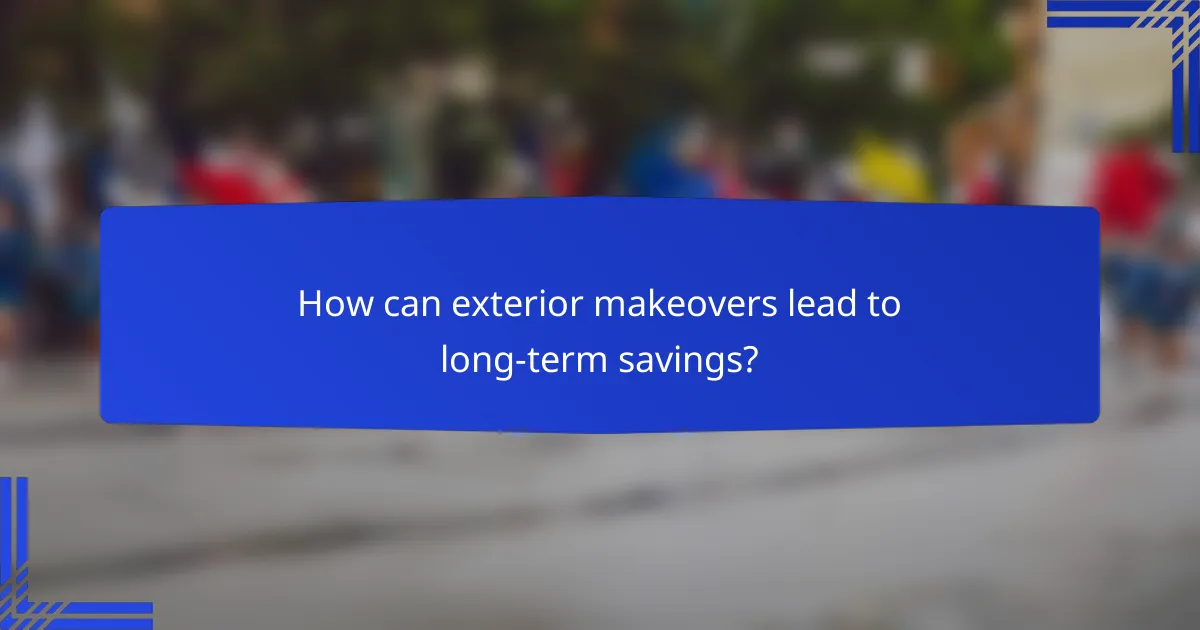When considering an exterior makeover, homeowners should be aware of the various pricing factors that can influence the overall cost, such as material quality and regional labor expenses. Additionally, there are multiple financing options available to help fund these projects, each with its own advantages and disadvantages. Beyond the initial investment, a well-executed exterior makeover can lead to significant long-term savings through improved energy efficiency and increased property value.

What are the key pricing factors for exterior makeovers in the UK?
The pricing of exterior makeovers in the UK is influenced by several key factors, including material quality, project size, regional labour costs, seasonal variations, and necessary permits. Understanding these elements can help homeowners budget effectively and make informed decisions.
Material quality and type
The choice of materials significantly impacts the overall cost of an exterior makeover. High-quality materials, such as natural stone or premium siding, tend to be more expensive but offer better durability and aesthetics. In contrast, budget options like vinyl or composite materials can lower upfront costs but may require more frequent replacements.
When selecting materials, consider not only the initial price but also the long-term maintenance costs and energy efficiency. Investing in better materials can lead to savings over time through reduced maintenance and energy bills.
Project size and scope
The size and complexity of the project directly affect the total cost. A small refresh, such as repainting or minor repairs, will generally be less expensive than a full renovation that includes structural changes or extensive landscaping. Homeowners should assess their needs and prioritize tasks to manage costs effectively.
For larger projects, obtaining multiple quotes from contractors can help identify competitive pricing and ensure the scope of work aligns with the budget. Breaking the project into phases may also spread costs over time.
Labour costs in different regions
Labour costs for exterior makeovers can vary significantly across the UK. Urban areas, particularly London, often have higher labour rates due to increased demand and living costs. In contrast, rural regions may offer more affordable labour options.
When planning a makeover, it’s beneficial to research local labour rates and consider hiring contractors from areas with lower costs, provided they have a good reputation and experience in exterior work.
Seasonal pricing variations
Seasonal changes can influence pricing for exterior makeovers. Spring and summer are peak seasons for home renovations, often leading to higher prices due to increased demand. Conversely, autumn and winter may present opportunities for discounts as contractors seek to fill their schedules during slower months.
Homeowners should consider timing their projects for off-peak seasons to potentially save on labour and material costs, while also ensuring that weather conditions are suitable for exterior work.
Permits and regulations
Depending on the scope of the exterior makeover, certain projects may require permits or adherence to local regulations. For instance, significant structural changes or additions may need planning permission, which can add to the overall cost and timeline of the project.
Before starting any work, homeowners should check with their local council to understand the necessary permits and regulations. This proactive approach can prevent unexpected delays and additional expenses during the renovation process.

What financing options are available for exterior makeovers?
Several financing options exist for homeowners looking to fund exterior makeovers, including loans, credit cards, government grants, and personal savings. Each option has its benefits and drawbacks, making it essential to evaluate which method aligns best with your financial situation and project needs.
Home improvement loans
Home improvement loans are specifically designed to finance renovations and upgrades. These loans can be secured or unsecured, with secured loans typically offering lower interest rates due to collateral, such as your home. Borrowers can often access amounts ranging from a few thousand to tens of thousands of dollars, depending on creditworthiness.
When considering a home improvement loan, check the terms, interest rates, and repayment periods. It’s advisable to shop around for the best rates and to read the fine print regarding fees and penalties.
Credit card financing
Using credit cards for financing can be a quick way to fund smaller exterior projects. Many credit cards offer promotional periods with low or zero interest rates, which can be beneficial if you can pay off the balance within that timeframe. However, be cautious of high-interest rates that kick in after the promotional period ends.
To avoid debt accumulation, limit the amount charged to your credit card and ensure you have a repayment plan in place. Consider using a card that offers rewards or cashback for additional benefits.
Government grants and incentives
Government grants and incentives are available in various regions to encourage home improvements, particularly those that enhance energy efficiency. These programs can significantly reduce the overall cost of your exterior makeover. Eligibility often depends on factors like income level, project type, and location.
Research local and federal programs to determine what is available in your area. Websites like Energy.gov provide resources for finding grants and incentives that may apply to your project.
Personal savings and budgeting
Using personal savings for an exterior makeover is a straightforward option that avoids debt. By budgeting for your project, you can set aside funds over time, allowing for a more controlled spending approach. This method eliminates interest payments and gives you full ownership of your improvements.
To effectively save, create a dedicated savings account for your project and set a monthly savings goal. This can help you stay on track and ensure you have the necessary funds when you’re ready to start your makeover.

How can exterior makeovers lead to long-term savings?
Exterior makeovers can significantly reduce ongoing costs by enhancing energy efficiency, increasing property value, and lowering maintenance expenses. These improvements not only provide immediate aesthetic benefits but also contribute to long-term financial gains.
Energy efficiency improvements
Upgrading insulation, windows, and roofing during an exterior makeover can lead to substantial energy savings. For instance, replacing old windows with energy-efficient models can reduce heating and cooling costs by 10-25%. Consider investing in materials that meet local energy codes to maximize efficiency.
Additionally, features like reflective roofing or energy-efficient siding can lower energy consumption, leading to lower utility bills. Homeowners should evaluate the potential return on investment when choosing energy-efficient upgrades.
Increased property value
An exterior makeover can boost your home’s market value by enhancing curb appeal and modernizing its appearance. Homes with updated exteriors often sell for 5-15% more than similar properties without renovations. This increase can be particularly pronounced in competitive real estate markets.
Investing in high-quality materials and designs that align with neighborhood trends can further elevate property value. Homeowners should consider consulting local real estate agents for insights on what improvements yield the best returns in their area.
Reduced maintenance costs
New siding, roofing, and paint can significantly decrease the frequency and cost of maintenance. For example, high-quality vinyl siding often requires less upkeep than traditional wood, saving homeowners both time and money. Regular maintenance costs can drop by 20-50% with the right materials.
When planning an exterior makeover, choose durable materials that withstand local weather conditions to minimize future repairs. Investing upfront in quality can lead to long-term savings on maintenance.
Insurance premium reductions
Upgrading your home’s exterior can lead to lower homeowners insurance premiums. Insurance companies often offer discounts for features like impact-resistant roofing or updated electrical systems, which reduce risk. Homeowners may see savings of 5-15% on their premiums after completing significant renovations.
Before starting an exterior makeover, consult with your insurance provider to understand potential discounts. Documenting improvements can help in negotiating better rates and ensuring adequate coverage for your newly enhanced home.

What are the best practices for selecting a contractor in the UK?
Selecting a contractor in the UK requires careful consideration of their qualifications, reputation, and the terms of your agreement. Following best practices can help ensure you choose a reliable professional for your exterior makeover project.
Checking credentials and reviews
Start by verifying the contractor’s credentials, including their qualifications, licenses, and insurance. In the UK, reputable contractors often belong to professional bodies such as the Federation of Master Builders (FMB) or the National Federation of Builders (NFB).
Additionally, read online reviews and testimonials from previous clients. Websites like Trustpilot and Checkatrade can provide insights into a contractor’s reliability and quality of work.
Obtaining multiple quotes
Gathering multiple quotes is essential for comparing costs and services. Aim to get at least three detailed estimates from different contractors to understand the market rate for your project.
When reviewing quotes, ensure they include a breakdown of materials, labor, and any additional fees. This transparency will help you make an informed decision and avoid unexpected costs later on.
Understanding contract terms
Before signing a contract, carefully review all terms and conditions. Ensure the contract outlines the scope of work, payment schedule, and completion timeline to prevent misunderstandings.
Pay attention to clauses regarding warranties and dispute resolution. A well-defined contract protects both you and the contractor, ensuring that expectations are clear and legally binding.

What are common mistakes to avoid during an exterior makeover?
Common mistakes during an exterior makeover can lead to increased costs and unsatisfactory results. Being aware of these pitfalls can help ensure a successful renovation that meets both aesthetic and functional goals.
Overlooking local regulations
Failing to consider local regulations can result in fines or required modifications after work has begun. Before starting your exterior makeover, check with local authorities for zoning laws, building codes, and permit requirements.
For example, some areas may have restrictions on the types of materials you can use or the height of structures. Ignoring these rules can delay your project and add unexpected costs.
Ignoring long-term maintenance
Neglecting to plan for long-term maintenance can lead to higher expenses down the road. Choose materials and designs that are durable and easy to maintain, as this will save you time and money in the future.
For instance, opting for high-quality siding or roofing can reduce the frequency of repairs and replacements. Consider the climate in your area, as certain materials perform better under specific weather conditions.
Underestimating project costs
Underestimating project costs is a common mistake that can derail your budget. It’s essential to account for all aspects of the makeover, including materials, labor, permits, and unexpected expenses.
A good rule of thumb is to add a contingency of about 10-20% to your budget to cover unforeseen costs. Detailed planning and getting multiple quotes can help you better understand the financial scope of your project.
